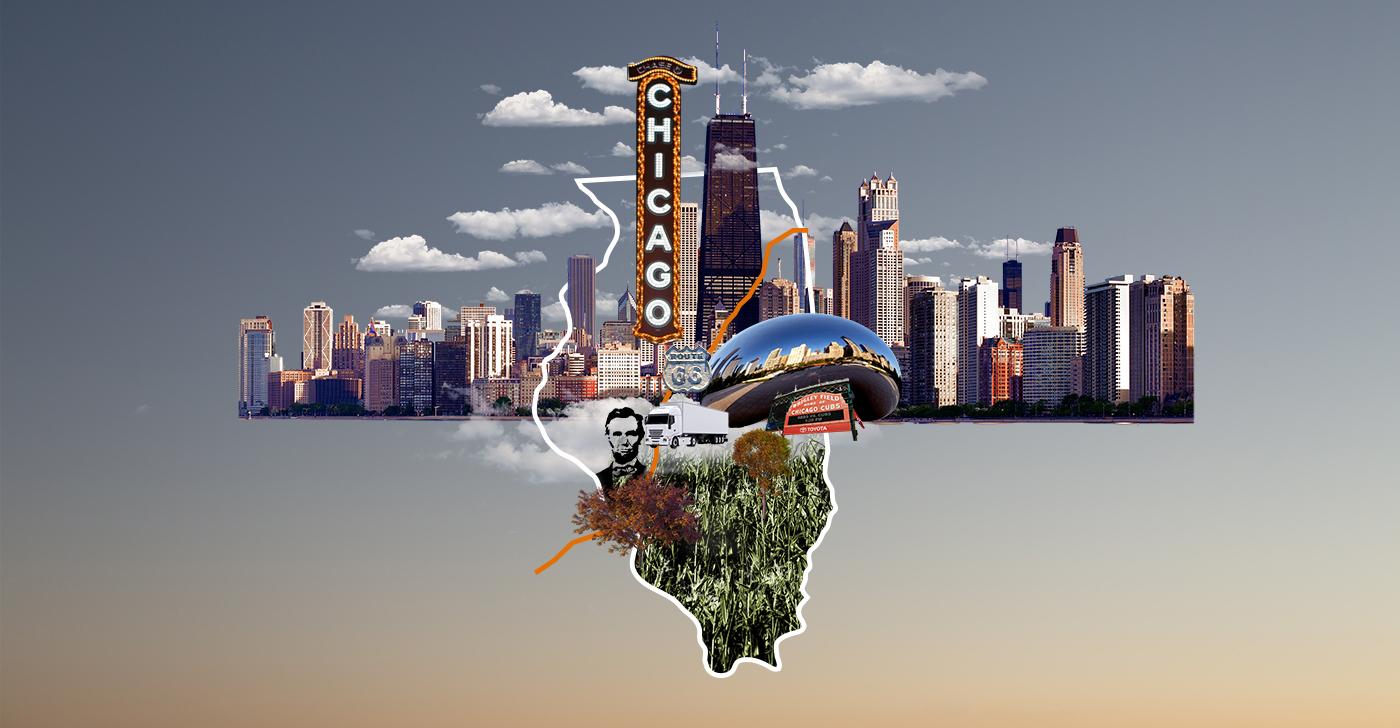Why are People Leaving Illinois? Illinois Exodus Migration Report 2023

European immigrants poured into Illinois in the 19th century, followed by African Americans in the 20th. But Illinois’s popularity is over. Today, more Illinoisans are leaving than moving in. Behind just New Jersey and California, the state ranks 3rd for outmigration.
In an era of railroads and steamships, Chicago sat at the crossroads of the country. Its “big shoulders” nurtured farmers on the prairies to the west, helping them move their goods to the powerful east-coast cities. With plenty of factories, shipyards, and slaughterhouses, it became a destination for Irish, German, Jewish, Polish, and Italian immigrants. In fact, 1870’s Chicago was comprised of 79% foreign-born immigrants and their children.
By WWI, it caught the attention of a new wave of migration: half a million African Americans leaving the South for better lives in the mid-20th century. By the late 20th century, farms still dominated the south and west of the state. But Chicago was a booming metropolis.
The Chicago area came to represent the urban American dream. It was popularized as a haven for families, home to the Griswolds of Vacation fame, the Winslows of Family Matters, the Portokaloses with their Big Fat Greek Wedding, and the McAllisters from Home Alone. By the time Ferris Bueller took his intrepid day off, Chicago’s reputation as a melting pot was already part of the American landscape.
Illinois is no longer the place to be. It’s third in the country for outbound moves, behind just New Jersey and California. In 2022, we found there were many more searches for moves out of state than in: 42 Illinois newcomers for every 100 ex-Illini.
Table of Contents
- Leaving Illinois: Statewide trends from the last decade and during the new decade’s beginning.
- 2022 Forecast: Which cities are losing the most residents? Where are their residents moving?
- Fastest Declines: According to census data, which cities are shrinking fastest?
- Real insights: We asked locals, why are people leaving Illinois?
- Sources and Methodology
Big Takeaways
- 2022 data for state-to-state moves shows that for every 42 moves into Illinois there are 100 out, the third-highest outbound interest in the US this year.
- Top states for Illinoisans headed out in 2022: Florida (15.31%), Texas (11.49%), and California (10.18%)
- Schaumburg, Illinois, is seeing the steepest decline, where almost 75% of the moves in the city are outbound.
- 5 top cities for those exiting Illinois in 2022, in this order, are: Ocala (FL), Seattle, Austin, Los Angeles, and New York.
- The #1 most searched route in early 2022: Downers Grove, Illinois to Ocala, Florida.
- The biggest-losing large city is Rockford (losing 5.5% of its population), while the mid-size prize was taken by North Chicago (-10.94%). Small city Nevada, IL has seen the steepest population decline over the last decade (a whopping -84%).

1. Goodbye, Land of Lincoln: Locals are Moving Away from Illinois
2020 to 2021 was a time of great migration across the country, but Illinois fared worse than most other states: from April 2020 to July 2021, The Land of Lincoln lost just over 141,000 residents. By 2022, half of Illinoisans were thinking of leaving, and most would-be relocators cited taxes as their #1 reason for calling it quits.
Illinois has the highest effective property tax rate in the nation, paying more compared to the value of their homes than other states’ residents. The state also has the 10th largest tax burden nationally, with the combined impact of personal income tax, property, sales, and business taxes comparatively high.
Others blame the decline of manufacturing, high housing costs, sluggish immigration, low birth rates, and college students who don’t return home to find jobs and contribute to Illinois communities.
Regardless of why they leave, they take high incomes with them. The IRS estimates more than $16 million in tax dollars left Illinois from 2019 to 2020 as residents moved away, leaving less money to rebuild infrastructure, invest in schools, or complete projects that would attract more jobs and people to the state. That’s not the worst of it. The total wealth lost in Illinois’ outmigration tops $8 billion, more than any state except New York.
The truth about Illinois’ outflow problem is outflow often begets outflow. As the pandemic allowed for more early retirements, remote work, and quality-of-life moves, Illinoisans increasingly decided to join the exodus, often opting for sunnier climates and lower taxes.
Illinois is Losing More Residents Than All But Two States
We analyzed over 240K search queries for interstate moves in 2022 to see which states had the worst in-to-out ratio. Illinois came in third, worst. About 2.5 times as many residents are looking to leave than move in.
| State | In-to-Out Move Ratio |
| New Jersey | 34 to 100 |
| California | 37 to 100 |
| Illinois | 42 to 100 |
| New York | 47 to 100 |
| Maryland | 49 to 100 |
With 81% of Illinois counties losing residents in 2021, the search query results confirm overall population trends in the once midwestern titan. Illinois’s loss has now dropped it to the country’s 6th most populous state.
A Quarter of Movers are Heading to Florida or Texas
They’re putting away their down coats and snowblowers, with about 1 of every 6 movers choosing #1 Florida as their new home and 1 out of 10 heading to #2 Texas.
After these balmy favorites, Illinoisans head to #3 California, #4 Arizona, and #5 North Carolina. Almost 47% of Illinois movers are choosing one of these destinations, and they’re in good company. Other than California, the country’s population loss leader of 2021, other states in the top five are all pandemic relocation winners, known for sun, affordable living, and high quality of life.
One thing is for sure: Illinois-exiters are not staying in the midwest, and even corn mazes and “midwest nice” can’t keep them there. Only one nearby state—Indiana—made the top ten list of places where Illinoisans are moving, grabbing just 3.14% of Illinois’s movers.
 2. 2023 Forecast: Illinoisans are Fanning Out Across the Country
2. 2023 Forecast: Illinoisans are Fanning Out Across the Country
Illinois is losing residents, but not every city is equally affected.
We looked at the inflow and outflow rates to see which (if any) Illinois cities are thriving while others lose residents and which are shedding residents fastest.
First, we dove into the 2022 moving data to see the most updated info on:
- What the basic inflow to outflow ratio was for every city in Illinois. That helped tell a story of what cities will see the largest effects of the migration this year and predict future population growth or decline based on interest (or lack thereof) in certain areas.
- When residents leave Illinois, where are they going? Which cities are most popular in their new home states?
- Which cities are in fashion for movers from Illinois versus downstate? Are different movers going to other destinations?
Illinois’ Biggest Outflow Comes from Suburban and Rural Areas
Of the 16 Illinois cities with more than 25 inquiries in and out, just one had a positive inflow/outflow ratio: Oak Park. That means more are moving in than moving out. In general, close-in suburbs fared better than their exurban counterparts, with small cities across the state and suburbs having the most brutal commutes shedding the most residents.
Chicago itself falls somewhere in the middle: for every 100 folks leaving, it saw 73 new residents coming in. Put in other words, 57.78% of all move searches involving Chicago were searching to move out.
First, let's look at Illinois’ most popular town: Oak Park. This charming suburb with great restaurants and easy access to Chicago saw 140 inbound inquiries for every 100 outbound inquiries — completely defying the outflow trend. Being named one of the top five “sexiest suburbs” by Chicago Magazine couldn’t have hurt. With tree-lined boulevards and Frank Lloyd Wright’s prairie-style home and studio, it’s a classic slice of Americana.
More distant suburbs are Chicagoland’s biggest losers. The other 15 cities lost more residents than they gained, but the places with the highest proportional outflow are in this order: Shaumburg, Bloomington, and Deer Creek.
Schaumburg is an hour-long commute from downtown Chicago, and without needing to make that commute, many of its residents have decided that high urban home prices and property tax bills aren’t worth staying put.
However, rural areas are also hard-hit. Bloomington, a college town near Illinois State University and Illinois Wesleyan University, has seen its population decline since 2013. It’s been hit by the loss of manufacturing plants and high-earning potential students, finding that after graduation, there are more job opportunities elsewhere.
Champaign, another college town that comes in #6 on the list for highest outflow compared to inflow, is also likely a victim of the post-collegiate “brain drain” in which alumni educated in Illinois universities find there aren’t enough jobs to stay put after graduation.
Thirty minutes down the road just outside of Peoria, Deer Creek faces a similar decline, with rural residents more likely to find jobs and a better quality of life outside this tiny village.
Illinoisans are Packing Up and heading to Florida in 2022
Do Illinoisans have a go-to destination in the Sunshine State and elsewhere? Using moveBuddha data, we mapped the top destination cities across the nation to find out.
| Rank | City, State |
| 1 | Ocala, Florida |
| 2 | Seattle, Washington |
| 3 | Austin, Texas |
| 4 | Los Angeles, California |
| 5 | New York, New York |
| 6 | Denver, Colorado |
| 7 | Phoenix, Arizona |
| 8 | Charlotte, North Carolina |
| 9 | Tampa, Florida |
| 10 | Houston, Texas |
| 11 | Dallas, Texas |
| 12 | Las Vegas, Nevada |
| 13 | Atlanta, Georgia |
| 14 | Nashville, Tennessee |
| 15 | Boston, Massachusetts |
| 16 | San Francisco, California |
| 17 | San Diego, California |
| 18 | Portland, Oregon |
| 19 | Indianapolis, Indiana |
| 20 | Miami, Florida |
Fun fact: The average high in January in Miami is more than twice that of Chicago. Maybe that’s why Illinois residents who move out of state are most likely to choose Florida as their new home. In fact, 3 of the top 20 destination cities are in the Sunshine State.
#1 Ocala isn’t just popular with Chicagoans. It’s the fastest-growing Florida city overall. For every 100 residents leaving Ocala, a whopping 594 are moving in. With more than 30 age-restricted 55+ communities, it’s a fair guess that many boomers who retired early due to Covid are hitting the 80+ golf courses in Ocala.
#9 Tampa and #20 Miami are also winners with Illinois residents. Both are large cities with plenty of amenities, which might make them feel a little bit like Chicago to urban dwellers not looking to give up culture, art, concerts, and restaurants.
Big cities take the overwhelming majority of Illinois transplants. All the most popular destinations in California and Texas are large cities. #4 Los Angeles, #16 San Francisco, and #17 San Diego give Illinoisans the big city life. In Texas, popular destinations #3 Austin, #10 Houston, and #11 Dallas likewise offer plenty of places to sample Chicago deep dish pizza hundreds of miles from home.
3 for 3: Actually the 3 most populous states — Florida, Texas, and California — each are home to 3 of the 20 most popular cities for those leaving Illinois.
Diverse Routes Rule Outbound Moves
Illinois residents have a lot of diverse ideas about what constitutes the perfect destination. When they’re looking to call somewhere new home, the only thing their choices have in common is a big city vibe.
| Rank | Most searched routes: From X to X |
| 1 | Downers Grove, Illinois to Ocala, Florida |
| 2 | Chicago, Illinois to Seattle, Washington |
| 3 | Chicago, Illinois to Los Angeles, California |
| 4 | Chicago, Illinois to New York, New York |
| 5 | Chicago, Illinois to Austin, Texas |
There is one mid-sized city right at the top of the list of top destinations for Illinois residents.
It turns out that Chicago’s suburbanites are partial to Ocala's small central Florida community. That might reflect that movers from this wealthy suburb (the median household income is around $97K, well above the national average, while its percentage of families living in poverty is lower) are well-established retirees at the end of a long career.
However, urban Chicagoans don’t want to give up the bright lights of the Second City. They’re heading all over the map: Seattle, Los Angeles, New York, and Austin. The only thing these cities have in common is their size.
They won’t always offer any savings on real estate or taxes. Instead, they’re destinations that provide a fresh start, far from home, but with a touch of Michigan Avenue.

3. Fastest-declining Small, Medium, and Large Cities in Illinois
You might think that while Illinois residents could cuddle up, stay inside, and work remotely during the global Covid-19 pandemic, they might be more amenable to the state’s famously harsh winters. However, the opposite was true. Illinois lost people during the pandemic faster than most other states. The newfound freedom that many found to retire or work from home added fuel to the fire of the state’s longstanding population decline.
We wanted to look at losses based on the size of cities in Illinois, so the most significant declines wouldn’t be concentrated among the state’s largest cities. So we broke down Illinois cities by category, which helped us compare how many cities were really shrinking most from 2010 up to 2022.
The categories are:
- Large cities: 100K+ population
- Mid-size cities: 10K to 100K population
- Small cities: Under 10K population
Using the percentage decline, we discovered that some cities are losing more residents than others.
Here is a map of the top cities (hover over each one for information on size, housing prices, and population decline trends):
Here are some patterns we noticed:
- 6 of the 10 large cities losing most of their population are concentrated in the Chicago area, while the trend is reversed for small cities. Far-Southern Illinois has 8 of the top 10 biggest-losing small cities.
- Home costs aren’t to blame. Among large cities with the most losses, the median home price in June 2022 was just over $246K, 34% less than the national average. And not all those cities’ homes gained value between 2010 and 2022.
- But some locations are seeing price hikes: North Chicago median real estate values increased 42% from 2020 to 2022 alone, increasing from $122,374 to $174,243. Affordable, but not for long.
- The biggest losing city is Rockford, which saw a 5.5% decline in population from 2010 to 2020, followed by Peoria with 4.8%.
- North Chicago lost more people than other mid-sized cities.
- While southern Illinois’ Alexander County is Illinois’ biggest losing county, shedding 36% of its population, the small city that lost more residents than anywhere else is Nevada, IL, in Livingston County.
Chicago Blues: Large Cities in Cook County Shrinking Fastest
Mid-size Cities: North Chicago, Macomb, and Canton Residents Saying Goodbye
Like the largest declining cities, the mid-sized cities shedding the most residents are clustered in the north and central parts of Illinois, where they once functioned to serve prosperous hubs.
Many still linger on the outskirts of cities with their own declining populations, like St. Louis, MO. #4 Cahokia, #5 Centreville, and #10 Belleville are typical for the area: 70% of St. Louis suburbs are losing residents.
#3 Canton, just outside Peoria, has long struggled to maintain jobs. First, it was home to a coal mining operation that left the town susceptible to sinkholes. A plow factory closed in the early ’80s. Recently, an ethanol plant fizzled, too. With the state of new jobs uncertain, residents are trading corn fields for new job opportunities and a better life elsewhere.
The median home price in Illinois is expected to reach $261,561 by the end of 2022. Which means that the most expensive place to live among the medium cities, #1 North Chicago, is still a wallet-friendly $174,243. Looking for a better bargain? You could settle in Centreville, where the median price is just $39,005.
Affordable housing is a hot-button issue elsewhere in the country, with expensive housing a significant push factor leading residents from cities known for their housing bubbles amidst a new, remote work revolution.
That’s not the case in Illinois, where low prices reflect years of infrastructure neglect and lost population. Empty home inventory lowered prices, flattened property taxes, and further eroded infrastructure. These mid-sized cities looked worse for the wear, but residents paid high taxes as cities struggled to maintain services.
Declining home values and unemployment combine in these mid-sized cities to help make Illinois one of the top states for housing market risk, despite the illusion of affordability.
Small Cities: The Rural South Losing Population
Local insights: Why are People Leaving Illinois?
To learn a bit more about what's bringing about the exodus, we reached out to people who've actually lived in Illinois. Here's their take on why you'd want to leave (Hint: The rumors are true - taxes are high.):
Where Corn is King Again?
Illinois boosters claim that there’s agricultural tech and advanced manufacturing, from AI to robots, bursting out of central Illinois, but stereotypes about the region keep it from enticing newcomers who might help revitalize the economy.
But with Illinoisans themselves moving out, it seems that it’s a lack of opportunity in the present that has residents saying goodbye.
Until more tech opportunities reach more residents with more jobs, Illinois will struggle to retain residents. From Chicagoland’s suburbs to the riverside towns of Alexander County, nearly 400 miles away, all of Illinois feels the pain. Ironically, that’s because of its dominance in the last century, when its rivers and train routes led to the growth of cities built around industries that have since dried up.
Sure, maybe someday central Illinois can brand itself as a tech-forward “Research Triangle” à la the Raleigh/Durham/Chapel Hill area of North Carolina, which has successfully managed to capture the lion’s share of new residents to North Carolina.
It won’t be easy. But with Illinois’s history of welcoming a new, diverse population, being unafraid of hard work, and making smart moves (like going from a log cabin to the White House), we wouldn’t bet against the midwest’s most formidable state.
Planning a move to Illinois
If you've got an IL move on the horizon, these pages will help you:
- Best Illinois Movers Pretty straight forward, we looked at hundreds of movers across the state and these are the best ones in Illinois.
- Find your Illinois moving route Want detailed help for your move? Pick where you're moving to and from in Illinois, and we'll help you find out costs and movers
5. Sources & Methodology
This report primarily uses a combination of U.S. Census Bureau data and moveBuddha proprietary data. For understanding the cost of area homes we use Zillow’s Home Value Index and for rent data, we referred to Housing Data.
moveBuddha proprietary data:
This data was collected from January 1, 2022 through July 5, 2022 capturing searches by individuals who were either planning to move themselves or hire a moving company in the subsequent year.
We used this data to analyze:
Section 1:
- 2022 State-based in-to-out move ratio, +240K queries analyzed
- Most popular state for moves from Illinois in 2022, 7259 queries analyzed
Section 2:
- 2022 Illinois cities in-to-out move ratio, we limited data to cities with a minimum of 25 inbound queries and 25 outbound queries for a total of 16 cities.
- Most popular out-of-state cities for Illinois residents to move to in 2022
- Most popular routes for Illinois residents heading out of state in 2022
U.S. Census Bureau — population, median income, historical population data:
Historical population totals, April 1, 2010 to July 1, 2020. To understand the methodology for devising these population estimates, please refer to the official methodology for total resident population estimates.
Zillow — Zillow Home Value Index city data:
The Zillow Home Value Index or ZHVI provides us with the typical home value within each city at a given period of time.
Not what you were looking for?
Check out other categories that can help you find the information you need!

